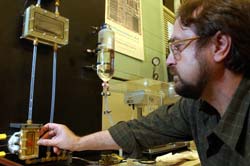Tiny bubbles are key to liquid-cooled system for future computers

Issam Mudawar, a professor of mechanical engineering at Purdue University, demonstrates the liquid-cooling system he has developed for future computers. Within about three years, microprocessor chips are expected to generate four times the amount of heat as current chips, requiring innovative cooling systems to keep the chips from being damaged by heat. (Purdue News Service Photo/David Umberger)
Purdue University researchers have made a discovery that may lead to the development of an innovative liquid-cooling system for future computer chips, which are expected to generate four times more heat than today’s chips.
Researchers had thought that bubbles might block the circulation of liquid forced to flow through “microchannels” only three times the width of a human hair. Engineers also thought that small electric pumps might be needed to push liquid through the narrow channels, increasing the cost and complexity while decreasing the reliability of new cooling systems for computers.
Purdue researchers, however, have solved both of these potential engineering hurdles, developing a “pumpless” liquid-cooling system that removes nearly six times more heat than existing miniature pumpless liquid-cooling systems, said Issam Mudawar, a professor of mechanical engineering.
Liquid forced through microchannels forms smaller bubbles than expected, Mudawar said he was surprised to learn. Moreover, decreasing the diameter of the microchannels increased the cooling efficiency of the system by causing the liquid to form even smaller bubbles, which is contrary to the expected result.
Because the bubbles are much smaller than the diameter of the microchannels, they flow easily through the channels. The Purdue-developed system does not require a pump because the liquid circulates in a self-sustaining flow in a closed loop that carries heat away from a computer chip.
Findings about the new cooling system are detailed in a research paper appearing in the March issue of IEEE Transactions on Components and Packaging Technologies, published by the Institute of Electrical and Electronics Engineers. The paper was written by Mudawar and graduate student Swaraj Mukherjee.
Innovative cooling systems will be needed in about three years for personal computers expected to contain microprocessor chips that will generate four times more heat than chips in current computers. Whereas current high-performance chips generate about 75 watts per square centimeter, chips in the near future will generate more than 300 watts per square centimeter, Mudawar said.
“Any time you squeeze more circuitry into the same space, you are producing more heat per unit area and per unit volume,” he said.
Today’s computers use fans and heat sinks containing fins to help cool circuitry. But this technology will not be efficient enough to remove the increasing heat generated by future chips, Mudawar said.
His research team created a liquid-cooling system that uses a closed loop of two vertical, parallel tubes containing a dielectric liquid – or a liquid that does not conduct electricity. The liquid flows through microchannels in a metal plate that is touching the chip. As liquid flows through the channels, it is heated by the chip and begins to boil, producing bubbles of vapor. Because the buoyant vapor bubbles are lighter than the liquid, they rise to the top of the tube, where they are cooled by a fan and condensed back into a liquid. The cool liquid then flows into the parallel tube and descends, creating a self-sustaining flow that eventually re-enters the microchannel plate and starts all over again.
“We were surprised to see that the dielectric liquid forms really miniature bubbles, so they slip through really fast,” Mudawar said. “The bubbles don’t block the flow, as you would expect.”
The researchers found that the system was 5.7 times better at removing heat than existing miniature pumpless liquid-cooling systems.
“This is only a starting point, and much better performance might be possible,” Mudawar said.
Future research will focus on testing various designs to see which configurations work best.
“Now that we have a system that we know will work, we are going to test different geometries that will be beneficial to industry,” said Mudawar, director of the Purdue University International Electronic Cooling Alliance. The alliance brings together researchers from industry, government agencies and Purdue to design cooling systems for applications ranging from personal computers to spacecraft.
The research was funded by the U.S. Department of Energy’s Office of Science.
Writer: Emil Venere, (765) 494-4709, venere@purdue.edu
Source: Issam Mudawar, (765) 494-5705, mudawar@ecn.purdue.edu
Purdue News Service: (765) 494-2096; purduenews@purdue.edu
Media Contact
All latest news from the category: Process Engineering
This special field revolves around processes for modifying material properties (milling, cooling), composition (filtration, distillation) and type (oxidation, hydration).
Valuable information is available on a broad range of technologies including material separation, laser processes, measuring techniques and robot engineering in addition to testing methods and coating and materials analysis processes.
Newest articles

Properties of new materials for microchips
… can now be measured well. Reseachers of Delft University of Technology demonstrated measuring performance properties of ultrathin silicon membranes. Making ever smaller and more powerful chips requires new ultrathin…

Floating solar’s potential
… to support sustainable development by addressing climate, water, and energy goals holistically. A new study published this week in Nature Energy raises the potential for floating solar photovoltaics (FPV)…

Skyrmions move at record speeds
… a step towards the computing of the future. An international research team led by scientists from the CNRS1 has discovered that the magnetic nanobubbles2 known as skyrmions can be…





















